October 3, 2013
For 2013, a bigger, more diverse conference

Discover how your buildings can be energy efficient, resilient and profitable at BuildingEnergy NYC (
BE NYC) on Wednesday, October 16, 2013. With
24 fully-accredited sessions (AIA, BPI & USGBC) and five pre-conference workshops on October 15th, you’ll be able to cover timely topics like next steps in renewables, addressing air leakage in large buildings, new NYC Codes for resilience, cogeneration and more.
We’ve got an outstanding group of speakers for
BE NYC. Here’s a sample:
Les Bluestone, Blue Sea Development
Warren Liebold, NYC Department of Environmental Protection
Pat Logan, Enterprise Community Partners
Dan Rieber, Northern Manhattan Improvement Corporation
Scott Schultz, Advanced Solar Products
Steven Winter, Steven Winter Associates
Get equipped with practical information and inspired for a sustainable future.
Register HERE
BE NYC is co-presented by
GreenHomeNYC the
Northeast Sustainable Energy Association, and enjoys sponsorship from such notable organizations as The Community Preservation Corporation, The Natural Resources Defense Council, NYSERDA, ConEdison, NixonPeabody and The Bluestone Organization.
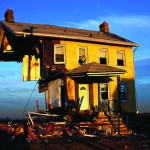 Hurricane Sandy: Point Taken
Hurricane Sandy: Point Taken – read Conference Chair Andy Padian’s
BuildingEnergy Magazine
story on urban resilience.
November 23, 2009
There has been considerable activity on the policy and regulatory front on every level – Federal, State, and City. This is excellent news for green building owners and advocates. This briefing aims to be just that – a concise look into a breadth of movement in fall 2009.
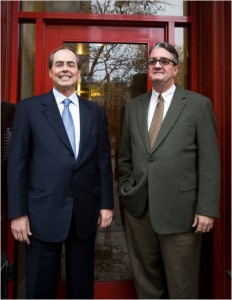
GreenHomeNYC's Andrew Padian of the Community Preservation Corporation, with Michael Lappin.
But first, the New York Times
ran a piece this week on the
Community Preservation Corporation and GHNYC’s very own
Andrew Padian. It cover’s the CPC’s new “green financing initiative” that offers mortgages or refinancing to landlords who fix inefficient energy and water systems in their buildings. The CPC projects that saving will be large enough for owners to cover the loan, and then some. The piece gets into detail on some strategies of older, inefficient buildings. Check it out.
Federal Government
– Senate Committee Passes the Clean Energy Jobs and American Power Act

– Cash for Caulking Program Debated
NYS Government
– Legislature Passes PACE enabling legislation
NYC Government
– Mayor Bloomberg releases 30 point plan to grow NYC’s green economy
Other
– USGBC releases report on national impact of green building on economy
– States slashing solar incentive programs
(more…)
August 18, 2004
with Dean Zias and Elizabeth Perry
(Scroll down for speaker bios.)
To get more details about specific programs, check out the links below, or download Elizabeth Perry’s
powerpoint presentation here.
[LINKS]
NYSERDA www.nyserda.org
PICCED www.picced.org
ENERGYSMART www.getenergysmart.gov
[Dean Zias on PICCED, NYSERDA, and energy-efficiency policies in New York State]
NYSERDA was founded in 1975 as a Public Benefit Organization (similar to a nonprofit) that concentrated on R & D and has only recently moved into the deployment of public programs. Its goal is to form a partnership between the public and private organizations, combining the “innovativeness of the private sector†with the “assurance of the public sectorâ€.
[ACTIONS ON THE FEDERAL LEVEL]
1992: The Department of Energy and the EPA developed the EnergyStar logo that we’re all familiar with. It indicates an appliance that is least 30% more efficient than average.
1996: The Department of Energy created the
Office of Energy Efficiency and Renewable Energy, which funds such projects as Rebuild America, Clean Cities (which deals with mass transit—providing cleaner buses, etc.), and the Weatherization Assistance Program.
The Rebuild America project funds PICCED, whose goals are to identify community needs and match those needs with resources, technical assistance, and finances for energy reform. It has strategic partnerships with professional groups like the AIA and businesses like GE and other high-powered, private R & D organizations.
Environmentalism has come a long way from the advocacy movement of the 1960’s, when ‘green’ concerns were seen as opposition to business. In this century, it’s finally being acknowledged that economic and environmental concerns go hand in hand.
[ACTIONS ON THE STATE LEVEL]
In the late 1990’s, Gov. Pataki deregulated the utility companies, separating suppliers and deliverers of energy and introducing market choice. The goal was the creations of a more competitive, innovative environment with more stable energy prices.
1998: The Systems Benefit Charge (SBC) was introduced by NYSERDA. A small percentage of the cost of every kw/hr goes into funding for research and development. Whenever this fund reaches $750 million, it will be put back into the energy services industry through investment and research. This fund, a partnership between ConEd and NYSERDA, is totally self-sustaining.
[NEW YORK STATE ENERGY POLICY]
Environmental Disclosure, aka the “State’s Report Cardâ€, is submitted at least twice a year by energy companies, by law. This reports emissions and sources of power used by the state.
Most New Yorkers don’t know that, as state residents, they have the right to choose the source of the power that they pay for. The majority of electricity supplied in New York State comes from coal, hydro-, and nuclear power, but ANY NEW YORK STATE RESIDENT can call up the utility company (it does not have to be ConEd) and request a particular type of power. This means that you, as the customer, determine the source of the electricity you use. This won’t affect your electricity availability or service (although the price may differ slightly) and it is open to any customer. For example,
Brooklyn Brewery is run entirely on green power.
Because this is so little-known, there are green power resources in New York State that are going unused. There are windmills in central New York State that are standing idle because residents don’t know they can request wind power.
Prices are constantly fluctuating, but in general, energy sources differ from one another in amounts of fractions of a penny. For example, when Dean called ConEd to request the switch, he found that he would be paying 12.9 cents per kilowatt hour—only 0.6 cents more than his current rate.
Four sources of green power
solar
wind
biomass
hydropower
[NYSERDA SERVICES]
BUILDING ASSISTANCE: NYSERDA offers assistance in the design and building stages of a new building or help with an existing building. It can provide technical assistance and a design review to help architects and builders, or help complete a building analysis (complete with financial information) of an existing building. This way, the benefits of various energy-efficiency measures can be planned for and calculated precisely. NYSERDA also aids with product specifications.
FUNDING: NYSERDA can identify funding sources for potential customers and even offers cash incentives for going green.
[Elizabeth Perry on NYSERDA’S Green Building Funding Programs]
Elizabeth works in NYSERDA programs focusing on commercial and industrial buildings or multi-family housing (more than 4 families): Smart Big Choices Program, New Construction Program
[ABOUT THE SYSTEMS BENEFIT CHARGE FUND (SBC)]
The small percentage deducted from energy bills was once rebated to customers. Now it’s put into the SBC the money goes into research and development, developing energy efficiency standards and helping low-income areas.
The funding is completely first-come, first-serve. When the money runs out, it will be time for the SBC to replenish itself. The state may re-fund NYSERDA, or may decide to use the money elsewhere. If you have a green building project and think you may be eligible for NYSERDA funding, apply as soon as possible! Please note that you MUST be a ConEd customer, since that is the source of the funding. ConEd customers pay into, and benefit from, the SBC.
[SAMPLE NYSERDA PROGRAMS]
GREEN BUILDINGS PROGRAM
The Green Buildings program is designed to minimize the environmental and economic impacts of commercial, industrial, and institutional buildings in NYS. Its long term goal is to make green design standard practice in all buildings.
Services:
Integrated whole-building analysis—beginning early in the design process
Energy-efficiency
Whole-building energy modeling
Cost-shared technical assistance:
LEED certification
Executive Order #111 (geared towards state buildings only; the goal of this is to get all state buildings up to speed and showcase energy efficiency)
NYS Green Building Tax Credit
Commissioning
NEW CONSTRUCTION PROGRAM The goal of this is to get as much electricity off-grid as possible.
250,000 available per measure.
400,000 per project
nyserda.org/869pon.html
LOAN FUND PROGRAM
Aimed towards the “Liberty Zone†below Canal to encourage development
Loan rate reduction of 4%
Lender/borrower fill out joint application
This can be combined with the green construction program.
Stay tuned for information about a possible followup forum on green lenders!
[Q&A]
note: paraphrased, not an exact transcript
Q: it seems overwhelming for the average user to understand all the NYSERDA programs. Is there someone to walk people through this process?
ELIZABETH: You can talk to Dean if your project is residential (a 1-4 family building). If it’s larger than that, you can come to me or to Anthony, who is part of our engineering team, to do an outreach.
DEAN: There are a lot of intervention points in our more than 2 dozen programs. My role as outreach coordinator is to find out your needs and work with you.
Q: Who pays into SBC?
ELIZABETH: Every ConEd customer, residential or commercial. LIPA and NIPA customers are not eligible. Their programs are similar to ours but not as well-developed. I did a school in East New York that turned out to be on the NIPA grid and was ineligible. Most places are eligible. If you’re doing work on city buildings, most of them are on NIPA power, but there is other funding available for greening city buildings.
Q: If you’re using the Green Buildings Program, can you apply to other programs?
ELIZABETH: Yes, as long as the money doesn’t overlap to pay for the exact same product.
Q: Is there software available to crunch numbers on energy efficiency?
ELIZABETH: Naturally.org, which is linked from the NYSERDA website, has calculators. However these calculators won’t tell you the energy-efficiency of the building itself.
DEAN: Rehabadvisor.com is good—it won’t tell you energy benefits but it will help analyze energy usage based on the number of windows or other factors. You still need analysis from engineers. There are too many synergistic effects, like the way sealed windows lead to less need for boiler heat. This stuff can’t be easily measured by calculators.
Q: Is there any funding available for roof construction on a small private school?
ELIZABETH: The New Construction Program can be used even on an existing building, if the building is vacant for at least 30 days (like during summer vacation). There are ways to workaround for existing buildings. For example, we worked on a warehouse. We allowed them to move all their inventory to one side. We retrofit the lighting on the other side of the warehouse and then switched.
Q: Can you expand on the guidelines for commissioning?
ELIZABETH: If you’re in the New construction program and receiving more than 100k. After the work is finished, we’ll want items that we paid for to be commissioned. This is still a new concept.
Q: The Green Buildings Program ends this December, right?
ELIZABETH: New Construction will end in December. New applications will be issued next year, but funding is running out, so the new program will have the same name but different tax information.
Q: The SBC money runs through 2006. Does it run out or is it sustainable through our electricity bills?
ELIZABETH: At that date, the Public Service Commissioner will determine whether NYSERDA gets the money or whether someone else should. But the SBC will continue to be funded through ConEd.
DEAN: They reevaluate the money because the funding is meant to revitalize the market. It may go to someone else. These [green building] programs actually pay for themselves over time—the NYSERD funding is just meant to speed it up.
Q: When is the best time to involve NYSERDA in my building project?
ELIZABETH: As early as possible! We want to be able to suggest changes to design teams: new materials, adding daylighting. It might even involve structural changes, so the goal is to get involved at the schematic design phase, before working drawings are made.
DEAN: Green is in the design phase. By the time you get to construction it’s too late. The earlier, the better.
Q: Who is eligible for the loan program?
DEAN: The Loan program applies to every NYSERDA program ,not just energy efficiency. We’re doing a green roof in Long Island City that is using this funding.
SPEAKER BIOS
Dean Zias has been an urban planner with the Pratt Institute Center for Community and Environmental Development (PICCED) for 26 years working with community groups in many housing and commercial revitalization projects in low- and moderate-income areas in NYC. He has recently been selected as NYSERDA’s partner to co-coordinate, along with Doreen Tabras of SoBRO, The Energy$mart Communities Outreach Program in New York City, a program that provides resources, guidance, technical assistance, financing, and monotoring in energy conservation, efficiency, and development in New York.
Elizabeth Perry joined the New York State Energy Research and Development Authority (NYSERDA) with 20 years of experience as an energy consultant in the Northeast. She has worked on residential, commercial and industrial projects in the public and private sectors. Some of those projects include assisting in the selection of energy-efficiency measures at the Whitehall Ferry Terminal and the Fulton Fish Market, and acquiring funding for photovoltaics at Whitehall; overseeing the implementation of metering and billing services at the Brooklyn Army Terminal and the Staten Island Homeport; helping in the selection of a new refrigeration system for the Brooklyn Wholesale Meat Market; and working with various cultural institutions to help them acquire discount energy. In her current position at NYSERDA, she is working to distribute funding to commercial and industrial facilities that will support energy-efficiency and green-building projects in the New York City area.
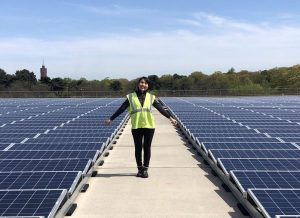 Seven seems to be an auspicious number for Zaira Akhmedova. Her professional journey spanned seven years as she made her way from a degree in finance and accounting to her current position as Financial Strategy Manager at EnterSolar, one of the largest commercial solar developers in the U.S. And it was her trip around the world—a seven-month sabbatical from work—that solidified her commitment to a career in renewable energy. (more…)
Seven seems to be an auspicious number for Zaira Akhmedova. Her professional journey spanned seven years as she made her way from a degree in finance and accounting to her current position as Financial Strategy Manager at EnterSolar, one of the largest commercial solar developers in the U.S. And it was her trip around the world—a seven-month sabbatical from work—that solidified her commitment to a career in renewable energy. (more…)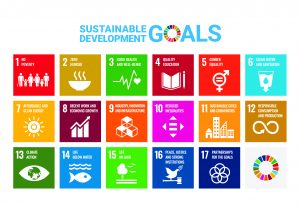 Ambitious Actions Needed: Sustainable Development Goals
The United Nations Sustainability Goals (SDGs) are helping both sectors to pursue environmental and humanitarian targets by providing a universal framework of seventeen integrated objectives needed to facilitate global environmental, social, and economic well-being by 2030.
Ambitious Actions Needed: Sustainable Development Goals
The United Nations Sustainability Goals (SDGs) are helping both sectors to pursue environmental and humanitarian targets by providing a universal framework of seventeen integrated objectives needed to facilitate global environmental, social, and economic well-being by 2030.
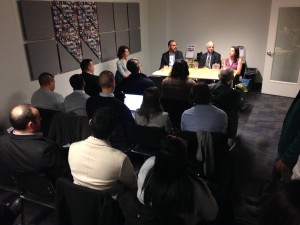 The panel shared their experience in financing options for green building projects, grants, and tax credits. They talked about how they have navigated their career paths and provided useful suggestions for job seekers and career transitioners. While the advice came from three experts in green finance, it was invaluable for anyone looking to grow in their careers. That was especially good news for this varied audience, which included building managers, students, and entrepreneurs, as well as finance professionals.
(more…)
The panel shared their experience in financing options for green building projects, grants, and tax credits. They talked about how they have navigated their career paths and provided useful suggestions for job seekers and career transitioners. While the advice came from three experts in green finance, it was invaluable for anyone looking to grow in their careers. That was especially good news for this varied audience, which included building managers, students, and entrepreneurs, as well as finance professionals.
(more…)
 Discover how your buildings can be energy efficient, resilient and profitable at BuildingEnergy NYC (BE NYC) on Wednesday, October 16, 2013. With 24 fully-accredited sessions (AIA, BPI & USGBC) and five pre-conference workshops on October 15th, you’ll be able to cover timely topics like next steps in renewables, addressing air leakage in large buildings, new NYC Codes for resilience, cogeneration and more.
We’ve got an outstanding group of speakers for BE NYC. Here’s a sample:
Les Bluestone, Blue Sea Development
Warren Liebold, NYC Department of Environmental Protection
Pat Logan, Enterprise Community Partners
Dan Rieber, Northern Manhattan Improvement Corporation
Scott Schultz, Advanced Solar Products
Steven Winter, Steven Winter Associates
Get equipped with practical information and inspired for a sustainable future.
Register HERE
BE NYC is co-presented by GreenHomeNYC the Northeast Sustainable Energy Association, and enjoys sponsorship from such notable organizations as The Community Preservation Corporation, The Natural Resources Defense Council, NYSERDA, ConEdison, NixonPeabody and The Bluestone Organization.
Discover how your buildings can be energy efficient, resilient and profitable at BuildingEnergy NYC (BE NYC) on Wednesday, October 16, 2013. With 24 fully-accredited sessions (AIA, BPI & USGBC) and five pre-conference workshops on October 15th, you’ll be able to cover timely topics like next steps in renewables, addressing air leakage in large buildings, new NYC Codes for resilience, cogeneration and more.
We’ve got an outstanding group of speakers for BE NYC. Here’s a sample:
Les Bluestone, Blue Sea Development
Warren Liebold, NYC Department of Environmental Protection
Pat Logan, Enterprise Community Partners
Dan Rieber, Northern Manhattan Improvement Corporation
Scott Schultz, Advanced Solar Products
Steven Winter, Steven Winter Associates
Get equipped with practical information and inspired for a sustainable future.
Register HERE
BE NYC is co-presented by GreenHomeNYC the Northeast Sustainable Energy Association, and enjoys sponsorship from such notable organizations as The Community Preservation Corporation, The Natural Resources Defense Council, NYSERDA, ConEdison, NixonPeabody and The Bluestone Organization.
 Hurricane Sandy: Point Taken – read Conference Chair Andy Padian’s BuildingEnergy Magazine
story on urban resilience.
Hurricane Sandy: Point Taken – read Conference Chair Andy Padian’s BuildingEnergy Magazine
story on urban resilience.
 GreenHomeNYC and the Northeast Sustainable Energy Association (NESEA) are teaming up once again to present BuildingEnergy NYC (BE NYC 13) on October 15-16, 2013 at the Marriott Marquis Hotel in midtown Manhattan.
BE NYC 13 is a must-attend conference for building owners, managers, financiers, contractors and policymakers with a keen interest in making urban structures more sustainable, efficient, and better able to withstand natural disasters.
Co-presented by GreenHomeNYC and NESEA, BE NYC 13 will offer 24 fully-accredited sessions and a high-level trade show at the Marriott Marquis (10/16) and five pre-conference workshops at host sites nearby (10/15). Topics include economics of solar for building owners, water conservation, building code, lessons from Hurricane Sandy and more.
Come for the content and connections, leave equipped and inspired for a sustainable future.
To learn more about BE NYC 13 check our conference page. Be sure to keep an eye on the GreenHomeNYC Blog for expanded coverage of the conference in the weeks to come.
GreenHomeNYC and the Northeast Sustainable Energy Association (NESEA) are teaming up once again to present BuildingEnergy NYC (BE NYC 13) on October 15-16, 2013 at the Marriott Marquis Hotel in midtown Manhattan.
BE NYC 13 is a must-attend conference for building owners, managers, financiers, contractors and policymakers with a keen interest in making urban structures more sustainable, efficient, and better able to withstand natural disasters.
Co-presented by GreenHomeNYC and NESEA, BE NYC 13 will offer 24 fully-accredited sessions and a high-level trade show at the Marriott Marquis (10/16) and five pre-conference workshops at host sites nearby (10/15). Topics include economics of solar for building owners, water conservation, building code, lessons from Hurricane Sandy and more.
Come for the content and connections, leave equipped and inspired for a sustainable future.
To learn more about BE NYC 13 check our conference page. Be sure to keep an eye on the GreenHomeNYC Blog for expanded coverage of the conference in the weeks to come.
 – Cash for Caulking Program Debated
NYS Government
– Legislature Passes PACE enabling legislation
NYC Government
– Mayor Bloomberg releases 30 point plan to grow NYC’s green economy
Other
– USGBC releases report on national impact of green building on economy
– States slashing solar incentive programs
(more…)
– Cash for Caulking Program Debated
NYS Government
– Legislature Passes PACE enabling legislation
NYC Government
– Mayor Bloomberg releases 30 point plan to grow NYC’s green economy
Other
– USGBC releases report on national impact of green building on economy
– States slashing solar incentive programs
(more…)

